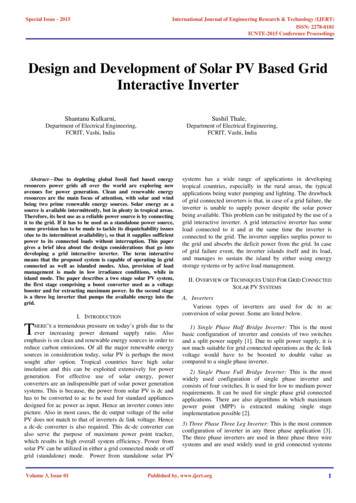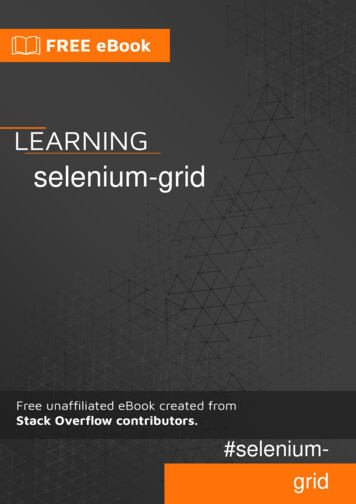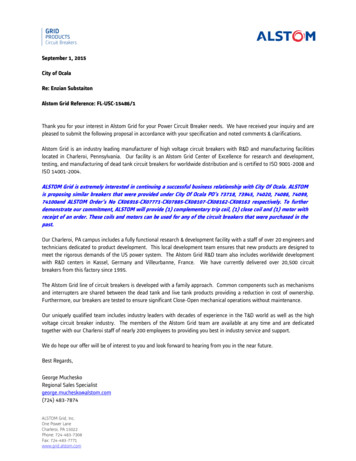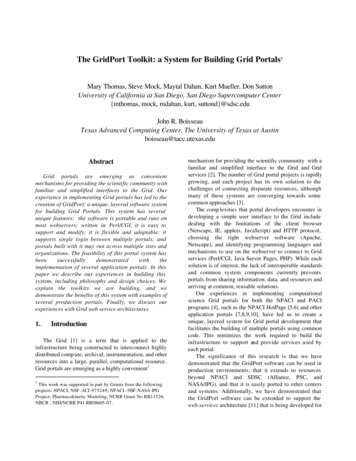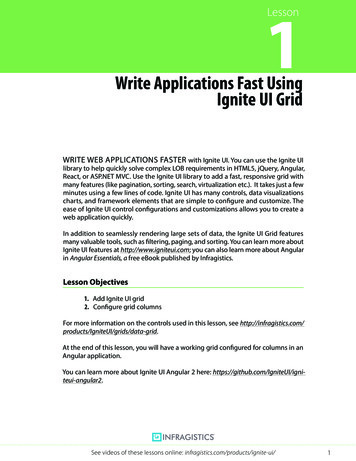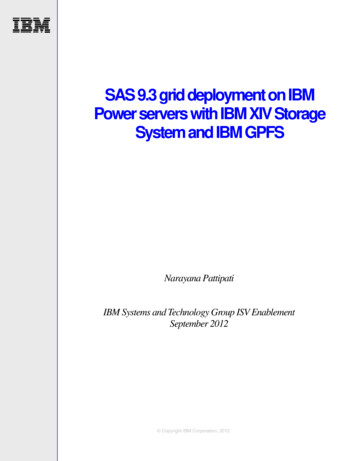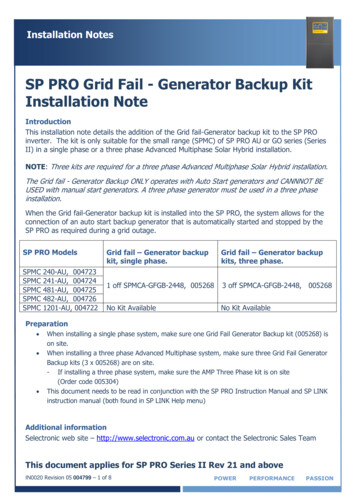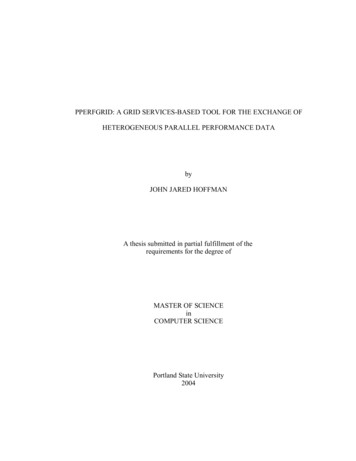
Transcription
PPERFGRID: A GRID SERVICES-BASED TOOL FOR THE EXCHANGE OFHETEROGENEOUS PARALLEL PERFORMANCE DATAbyJOHN JARED HOFFMANA thesis submitted in partial fulfillment of therequirements for the degree ofMASTER OF SCIENCEinCOMPUTER SCIENCEPortland State University2004
ACKNOWLEDGMENTSI would like to thank the following people for their help with this thesis: Dr. KarenKaravanic for the opportunity to work on PPerfGrid and for her guidance throughoutthe project, Andrew Byrd for his help in database and systems administration, andKathryn Mohror for advice and moral support.i
TABLE OF CONTENTSAcknowledgmentsiList of TablesvList of Figuresvi1 Introduction12 Related Work52.1 Data Warehousing52.2 Database Federation62.2.1 Database Integration and Mediation62.2.2 Application Integration72.2.3 Semantic Integration82.3 Grid-specific Virtualization Services102.4 Parallel Computing Performance Tools123 Technology Overview153.1 Web Services153.1.1 A Typical Web Services Scenario153.1.2 Extensible Markup Language (XML173.1.3 Simple Object Access Protocol (SOAP)183.1.4 Web Services Definition Language (WSDL)183.1.5 Universal Description, Discovery, and Integration (UDDI)183.2 Grid Services19ii
4 The PPerfGrid Architecture214.1 Architecture Overview224.2 Data Layer224.3 Mapping Layer224.4 Semantic Layer234.5 Services Layer274.6 Virtualization Layer294.7 Using PPerfGrid295 The PPerfGrid Implementation325.1 Data Layer Implementation325.2 Mapping Layer Implementation325.3 Semantic Layer Implementation335.3.1 PPerfGrid Application345.3.1.1 Attribute Discovery345.3.1.2 Querying Executions355.3.1.3 Creation of Execution Grid Services355.3.1.4 PPerfGrid Manager355.3.2 PPerfGrid Execution365.3.2.1 Foci, Metric, Type, and Time Discovery365.3.2.2 Querying Performance Results375.3.2.3 Performance Result Caching38iii
5.4 Services Layer Implementation395.5 Virtualization Layer Implementation415.5.1 Service Publishing and Discovery415.5.2 Application Query Panel435.5.3 Execution Query Panel445.5.4 Performance Results Visualization456 Experiments and Results476.1 Data Sources476.2 Performance Measurement Method486.3 Hardware and Network486.4 Grid Services Overhead486.5 Scalability516.6 Performance Results Caching537 Future Work558 Conclusions589 References60iv
LIST OF TABLES1 PPerfGrid Application PortType342 PPerfGrid Execution PortType373 OGSA PortTypes394 PPerfGrid Overhead505 PPerfGrid Caching54v
LIST OF FIGURES1 A Typical Web Services Scenario162 PPerfGrid Architectural Layers213 PPerfGrid Component Interaction304 Mapping Layer Example335 Semantic Layer Example386 Services Layer Example407 Virtualization Layer Example428 PPerfGrid Client: Service Publishing and Discovery439 PPerfGrid Client: Service Application Query Panel4410 PPerfGrid Client: Execution Query Panel4511 PPerfGrid Client Visualization Panel4612 PPerfGrid Scalability52vi
1 IntroductionModern, large-scale scientific and engineering projects frequently involvecollaboration between groups of scientists whose proximity to one another rangesfrom the same lab to completely different organizations dispersed in a variety ofcountries around the world. In addition, the groups working on these projects mayutilize heterogeneous computing resources, information systems, and instruments todo their research [21].With the emergence of low-cost, computing clusters built using commodityoff-the-shelf (COTS) hardware components and free software, a greater number ofscientists and engineers than ever before have access to cost-effective parallelcomputing [7], and they utilize parallel systems to run a variety of data-intensive andcompute-intensive applications. The applications that are run on high performanceparallel computers tend to have long runtimes and be extremely hard to optimize. Avariety of analysis tools [37, 1, 27, 38] have been developed that gather performancedata during the execution of an application, allowing system users to diagnose andrepair performance problems. The use of these analysis tools can significantlyincrease the performance of an application.While performance tools typically analyze a single execution of a parallelapplication, worthwhile information can also be gained by comparing data frommultiple executions of an application, even when the execution data has beengenerated by different analysis tools from runs in different hardware environments.However, performance tools produce data that has several barriers to use in this kindof collaboration. Performance data is often stored using a variety of different schemas1
and in a variety of different formats, from text files, to relational databases, to nativeXML. Performance tools also produce large quantities of data, possibly hundreds ofterabytes for one execution of an application. Finally, a variety of different platformsand implementation languages are used in the storage and management ofperformance data, making system interoperability a challenge.With the goal of overcoming these barriers to parallel performance datacollaboration, namely data heterogeneity, large amounts of data, and lack of systeminteroperability, this thesis presents PPerfGrid. This thesis demonstrates thatPPerfGrid is a useful, Grid services-based tool for efficiently sharing performancedata between geographically dispersed locations and collaboration in the analysis ofthis data.Data heterogeneity is resolved in PPerfGrid by abstracting the conceptscommon to parallel computing performance data as semantic objects. These semanticobjects, the Application and Execution, have standard interfaces that define how theyare accessed by clients. The implementation of the Application and Executionsemantic objects for each data store provides a mapping to their heterogeneousformats and schemas. These Application and Execution semantic objects aredeployed as Grid services. Grid services enable software components to be exposedon the Web as unique, stateful instantiations of static service concepts (e.g.Application and Execution), which communicate using platform and language-neutralprotocols. Grid services enable a uniform, virtual view of the performance data storesbeing compared. This view is uniform because, regardless of the formats or schemasof the data stores, data from different organizations is accessed through the same2
interfaces. This view is virtual because the use of Grid services provides locationtransparency—regardless of where the data stores are located, clients access them as ifthey were local software components.The use of Grid services enables PPerfGrid to deal with large parallelperformance data stores more efficiently. By instantiating Application and ExecutionGrid services on the same machine as the performance data store and providingfocused query interfaces, data transfer is minimized. Application and Execution Gridservices also perform data caching and can be dynamically distributed across severalhosts, improving scalability and performance by taking advantage of parallelism.Lack of system interoperability is also resolved by using Grid services. Gridservices communicate using platform and language-neutral protocols over the Web,and the Web services architecture that provides the basis for Grid services is availablefor a wide variety of different platforms and languages. Therefore, organizations canpublish their performance data for use with PPerfGrid regardless of their computingplatform or implementation language.PPerfGrid expands on previous work done by Portland State University'sPPerfDB Group. PPerfDB [28, 23] is a tool that can analyze multiple sets of parallelcomputing performance data, regardless of the analysis tool used to collect the data.PPerfXchange [9] is a PPerfDB module with similar goals to PPerfGrid but with amore traditional client/server architecture.This thesis details the approach taken in developing PPerfGrid. Section 2discusses other research related to this project. Section 3 provides general backgroundon the technologies utilized in PPerfGrid, focusing on the components that make up3
the Grid services architecture. Section 4 provides a description of the architecture ofPPerfGrid. Section 5 details the implementation of PPerfGrid. Section 6 presentstests designed to measure the overhead and scalability of the PPerfGrid application.Section 7 suggests future work, and Section 8 concludes the thesis.4
2 Related WorkThe PPerfGrid project is just one example of an area of information integrationknown as virtualization services. This section describes some of the major projects ineach category of virtualization services and how they relate to PPerfGrid.2.1 Data WarehousingData warehousing deals with heterogeneous data stores by extractinginformation from each source, translating and filtering the data as appropriate,merging it with data from other sources, and storing it in a centralized repository.Queries are evaluated directly at the repository, without accessing the original datastores. Because all data is stored in a single location in this approach, datawarehouses can benefit from efficient storage and fast searching. However, becausethe data is copied, data warehouses suffer from a latency problem, where informationin the warehouse can be out of date with respect to the source, depending on thefrequency of updates [48].Many examples of data warehouses exist, including the Protein Data Bank(PDB), the Alliance for Cell Signaling (AFCS), the Interuniversity Consortium forPolitical and Social Research (ICPSR), and the Incorporated Research Institutions forSeismology (IRIS). An emerging model is to package a data warehouse together witha software stack (OS, database system, system management software, and Gridsoftware) and a hardware platform (IBM's Shark), creating a self-contained storageappliance that acts as a building block for a Data Grid—a GridBrick [34].In order to avoid the problems of latency and the potentially large amounts ofstorage space required to maintain copied data in a central location, data warehousing5
was not used in the design of PPerfGrid.2.2 Database FederationIn contrast to data warehousing, a database federation leaves its members' dataat their respective source locations. When a client makes a request for data, therequest is sent to the appropriate source locations, who each handle the query in theirown way. The query results from each source location are then combined asappropriate and returned to the client. The main types of database federation aredatabase integration and mediation and application integration.2.2.1 Database Integration and MediationIn a mediated architecture, an extra software layer composed of mediatormodules is inserted between the client and the server, and the mediators bring sourceinformation into a common form. A mediator may have to use multiple standards toaccess its resources but can present a single interface to the client [49, 50].Data stores do not present all of their data to the federation, but instead publisha view of their data that adheres to the mediator data model. In many cases, in orderto publish this view, a data store must utilize a wrapper to translate source data intothe common format and structure of the mediator model. A formal query language,like SQL or XQuery can be used to make queries against the mediated model [34].The XMediator system from Enosys Software is an example of the wrappermediator database integration approach. The wrappers, called XMLizers, accessmultiple, distributed, heterogeneous information sources and export Virtual XMLviews of them. All the exported views are integrated into a Virtual Integrated XML(VIX) database. The VIX database supports the creation of virtual views and queries6
using XQuery. Queries and views are translated into the proprietary XCQL Algebra,combined into a single algebra expression/plan, and executed. The query processorthen lazily evaluates the result to XML, using an appropriate adaptation of relationaldatabase iterator models [35, 36].InfoGrid, an application developed by a group from the Imperial College ofScience Technology and Medicine in London, is another example of the wrappermediation approach. However, instead of using a built-in, specialized query languageand query-processing engine, InfoGrid allows its clients to use the native querymechanisms of the remote resources. In this case, the role of the mediator middlewareis to connect the users transparently to the remote resources, ensuring that they haveall knowledge about the resources available and providing them with the toolsrequired to construct heterogeneous queries and combine the results [16].PPerfGrid differs from these two applications primarily in that it accesses datathrough an application interface (see next section), instead of a full-featured querylanguage.2.2.2 Application IntegrationApplication integration differs from the approaches above in that it employs aprogramming language and its associated data model (e.g. an object-oriented classhierarchy) for its integration. Data stores are wrapped, with associated behaviors andmetadata, to return well-defined objects in the language model. Once the source datais represented as objects, arbitrary manipulation of these objects is possible using theprogramming language [10]. This is the general approach taken in PPerfGrid.One example of application integration is the Information Integration Testbed7
project at the San Diego Supercomputing Center. Like PPerfGrid, the I2T Testbedwraps data stores in the form of Web services, publishing a service interface (WSDL)rather than exporting database views and query capabilities. This approach has someadvantages because it provides a uniform interface to both data and computationalservices and therefore can be used to better control the types of queries/requestsaccepted by a source and the corresponding resources consumed [5]. UnlikePPerfGrid, the I2T Testbed does not leverage the additional functionality that Gridservices provide by extending Web services, namely the addition of stateful serviceinstances which enable optimizations that will be discussed in sections 4, 5, and 6 ofthis thesis.2.2.3 Semantic IntegrationSemantic data integration is required when communities (different labs orscientific disciplines) have created data stores that describe the same concepts but usedifferent terminologies. Semantic integration requires the definition of formalterminology or ontology structures to represent the concepts in each data source.The main purpose of an ontology is to make explicit the information content ina manner independent of the underlying data structures that may be used to store theinformation in a data repository. Ontologies are thus abstractions and can describedifferent types of data such as relational tables and textual and image documents.In this approach, users deal with ontologies (semantic information) instead ofdealing with multiple heterogeneous data repositories. An ontology also defines alanguage, or set of terms, that will be used to formulate queries, So, users formulatequeries over ontologies and the system has the responsibility of managing the8
heterogeneity and distribution in the repositories, usually through some form ofmediation [31].Many examples of ontology-based systems exist. The TSIMMIS project [8] isprimarily focused on the semi-automatic generation of wrappers, translators andmediators that map information in an object exchange model to the underlyingstructured or unstructured data. The InfoSleuth project [8] grew out of the Carnotproject, and its focus is on Web searching. A user makes requests to a software agentusing ontological objects, and this agent in turn communicates with other types ofagents (Broker Agents for advertising agent capabilities and routing requests,Resource Agents for mapping from the common ontology to a database schema, etc.)to return appropriate data to the user.PPerfGrid uses a simple and informal ontology implicitly in its Grid Serviceobject model. The Application and Execution Grid services and Performance Resultsare concepts represented in a hierarchy, with Application at the root of the tree andbranching to one or more Executions, which in turn branch to one or morePerformance Results. Instances of concepts are created when data is retrieved fromthe database(s) underlying the ontology, or PPerfGrid installation. In fact, theinterface to OBSERVER's Ontology Server [31] is similar in many ways to theinterface structure of PPG's Application and Execution services: OBSERVER's Getconcepts(WN) - { print-media, dictionary, book, .},Size-of(book,WN) - 1005, and Get-extension('[pages] fordictionary',WN) - tuple1, tuple2, . “services” act like9
PPG's getExecQueryParams(), getAppInfo(), and getExecs(attrib,val, operator) methods respectively.While PPerfGrid's ontology is represented implicitly, through its object model,interfaces, workflow, and informally specified semantics, almost all ontology-basedsystems represent their ontologies with some form of description logic language [45].These description logic languages also classify queries, which gives ontology-basedsystems a more complex, but potentially more expressive, method of asking questionsabout data. In the future, PPerfGrid could be extended to accept a description logiclanguage queries.2.3 Grid-specific Virtualization ServicesThe Open Grid Services Architecture (OGSA) does provide the basicarchitectural structure and mechanisms for creating service-oriented infrastructure andcan be applied to the challenges of integrated heterogeneous data stores, as has beenpresented in this thesis. However, several Grid projects are attempting to generalizedistributed data access on the Grid and provide a suite of Grid services to meet therequirements of data-intensive applications.The Data Access and Integration Services (DAIS) Working Group of theGlobal Grid Forum has produced a specification for OGSA Data Services. Theseservices extend the functionality provided by the OGSI by defining basic service dataand/or operations for representing, accessing, creating, and managing data services[13]. A reference implementation of DAIS has been produced by OGSA-DAI, a UKproject jointly funded by government and industry [11]. At the time this thesis waswritten, the DAIS specification had not yet been finalized and was therefore10
considered promising but not mature enough to be incorporated into theimplementation.The Chimera project is an effort to produce a Virtual Data Grid—a scalablesystem for managing, tracing, communicating, and exploring the derivation andanalysis of diverse data objects. Chimera grew out of the GriPhyN project, which isdeveloping Grid technologies for domains such as high energy physics and astronomy,where petrabyte-scale datasets are collected and analyzed. In Chimera's model, theview of a data system is expansive, with data objects (e.g. a file or a RDMS table), thecomputational procedures used to manipulate the data (transformations), and thecomputations that apply these procedures to data (derivations and invocations) aretreated as first class entities which can be published, discovered, and manipulated[14].Chimera relates to PPerfGrid in several ways. PPerfGrid has Application andExecution abstractions that provide virtual views of data through calls to uniforminterfaces. The implementation of these interfaces in turn maps to the local data store.Chimera takes a more generic and flexible approach. Each dataset maintains adescriptor, which tells a transformation how the dataset is mapped onto a storagedevice. Transformations are typed computational procedures (function definitions),which take arguments and a reference to a dataset and perform create, delete, read,and/or write operations. Derivations and invocations can be thought of as a record of aspecific function call with a given set of arguments, context information (date, time,processor, and OS), and potentially a reference to a new, transformed dataset replica.Both Chimera and PPerfGrid, therefore, shield the user from the low-level11
details of how data is represented by providing access through abstract data objects(Applications and Executions for PPerfGrid and datasets for Chimera) and allowoperations on this data by providing an interface to produce virtual data views.Chimera's architecture differs from PPerfGrid in that datasets, transformations,derivations, and invocations are first class entities, allowing a variety of differentstyles of applying procedures to datasets, including collocating the procedure with thedata, shipping the procedure to the data, shipping the data to the procedure, andshipping the procedure and data to another computer. These different styles allowmore flexibility in planning Grid resource allocation.Chimera presents very promising ideas and deserves to be considered forfuture work by the PPerfGrid group. However, its existence was not discovered untillate in PPerfGrid's development. In addition, the current release of Chimera is basedon an older, pre-Web services/Grid Services version of the Globus Toolkit, andtherefore does not have some of the compelling interoperability features of GT3.2.2.4 Parallel Computing Performance ToolsThe PerfDMF Project [25] addresses objectives of performance toolintegration, interoperation, and reuse. In PerfDMF, performance data is stored in arelational database, called the profile database, with a standard schema forrepresenting performance data. The entities in this schema include APPLICATION,EXPERIMENT, TRIAL, METRIC, INTERVAL EVENT, and ATOMIC EVENT. ThePerfDMF architecture includes a Java API that abstracts query and analysis operationsinto a programmatically accessible, non-SQL form which is intended to complementthe SQL interface. The API supports both an object-oriented query mechanism and an12
object wrapped representation, which hide the complexity of the profile database fromthe analysis program coder. The PerfDMF Project has also developed two clients.ParaProf is a platform for graphically browsing profile data through the PerfDMFAPI. The trial browser presents a tree browser for the application, experiment, andtrial hierarchy and includes charting and summarizing capability.While the PerfDMF Project and the PPerfGrid and PPerfDB Projects sharesome of the same goals, there are some important differences. PerfDMF is designedto allow the import of parallel profile data from multiple sources through embeddedtranslators to a profile database with a standard schema. In contrast, PPerfGrid'sapproach is to leave the performance data in its original format and location andprovide a uniform, virtual view of the data to users over the Grid. These twoapproaches present some interesting possibilities for collaboration. For example,PPerfGrid could be used to expose a PerfDMF profile database for analysis withperformance data from other locations.The Prophesy Project [43] is a performance analysis and modelinginfrastructure for parallel and grid applications. Prophesy uses an automatedmodeling component with the capability to develop models as the composition of theperformance models of the kernels that compose an application. By combiningparameterized models with coupling parameters, which quantify the interactionbetween adjacent kernels in an application, a better understanding of individual anddistributed systems can be gained. While Prophesy is focused on analyzing theperformance of parallel and Grid applications, PPerfGrid is focused on using the Gridas a medium for the virtualization and exchange of performance data. The two13
projects are potentially complementary, as PPerfGrid could be used to expose theinformation in the Prophesy Database to other performance analysis tools.ZENTURIO [41] is a tool to specify and automatically conduct a large set ofexperiments on cluster and Grid architectures, with the goal of supportingperformance analysis and tuning, parameter studies, and software testing. While notconcerned with the exchange of heterogeneous parallel performance data, ZENTURIOis an OGSA-based Grid application, and is similar to PPerfGrid in its use of OGSAfunctionality, including a UDDI-based service registry and the use of transient serviceinstances. In addition, ZENTURIO offers examples of some of the more advancedfunctionality that PPerfGrid will incorporate in the future, like event notifications andthe use of XPath to query service data.14
3 Technology OverviewThis section includes background on the Web services technologies used byPPerfGrid (XML, SOAP, WSDL, UDDI) and background on Grid computing andGrid services.3.1 Web ServicesThe emergence of the Web was driven by the need for scientific collaboration,and it has become the common, world-wide repository of all types of data, bothscientific and business. However, this data is published in a wide range of differentformats and is accessible with a variety of different access methods. Web accessusually takes the form of simple call interfaces without APIs or query languages andonly “point and click” visual interfaces [21]. The extreme volume of data nowaccessible on the web makes the primitive, inefficient nature of these interfacespainfully apparent.Web services technologies enable access to the Semantic Web, a term used todescribe an extension of the existing Web in which information is given a welldefined meaning that enables it to be programmatically accessed. The Semantic Webtransforms the Web into a medium through which data can be shared, understood, andprocessed by automated tools [30]. With the rich interfaces available on the SemanticWeb, the sharing and analysis of data involved in any collaboration immediatelybecomes more efficient, powerful, and compelling.3.1.1 A Typical Web Services ScenarioWeb services encapsulate software modules and publish them to the Web asservices. All communication between these services takes place using a variety of15
Publish (SOAP) service WebService (WSDL) Directory UDDILookup (SOAP)Communicate (SOAP)ClientNative Code (Java) Communication Protocol Java ServiceImplementationFigure 1: A Typical Web Services ScenarioThis diagram details a typical Web services scenario, which begins when a WSDLdocument is published to a UDDI registry. A Client accesses the directory and usesthe WSDL document to create native language stubs and bind to the Web service.The Client and Web service communicate using SOAP-formatted messages.open Internet standards. Web services allow Web-enabled data, and associatedoperations on that data, to be dynamically located, subscribed to, and accessed bysoftware, not just by human beings. Further, because Web services interact usingopen Internet standards, communication between the service and a client can occurregardless of their respective underlying computing platforms or programminglanguages. Web services are simply software components, so systems can becomposed of numerous Web services acting together with native code and libraries toproduce the desired functionality.As indicated in Figure 1, a typical scenario begins when a Web servicepublishes its interface, in the form of a WSDL document that describes the functionsignatures of the service, to a UDDI-based directory server, which is itself a WebService. The Client accesses the directory, using a variety of different search methods16
to locate a the Web Service and download its WSDL document. Based on the WSDLdocument, the Client can create native language stubs and bind to the Web Service.The Client, from the perspective of its internal code, then makes a call to the WebService as it would to any other object or module. This call is translated, through theWeb services stack, into a SOAP-formatted message and sent to the Web Service,which translates the incoming message into its native code format and makes acorresponding function call to the service implementation. Any results returned fromthis function call are translated again into a SOAP-formatted message and sent back tothe Client. The following sections describe the core Web services technologies(XML, SOAP, WSDL, and UDDI) in more detail.3.1.2 Extensible Markup Language (XML)XML [46] is a data format endorsed by the World Wide Web Consortium(W3C). XML documents are stored in Unicode text, and they represent complex datain a structured, self-describing format. Because the format of an XML document isboth structured and self-describing, any XML-enabled client can not only read thedata in the document, but also understand the form of that data, without needing, forexample, a database schema or a text file record descriptor. XML is a markuplanguage, using user-defined data description tags in a similar way to HTML to definea hierarchy of elements, with the leaves of the hierarchy containing actual data.Because all major computing languages have XML capabilities, the languagehas become the common language for the exchange of data between applications,systems, and devices across the Internet. The Web services paradigm uses XML as itscommunication protocol and as a basis for its other standards.17
3.1.3 Simple Object Access Protocol (SOAP)Simple Object Access Protocol (SOAP) [47] is an XML-based communicationprotocol. SOAP messages are simply XML-based documents with a specific structurethat is understood by both ends of a conversation. The SOAP message XMLhierarchy consists of and Envelope element which contains a Header, containingmeta-data that is used to determine how to process the message, and a Body,containing the contents of the message. Clients use SOAP to make requests to Webservices (request documents), and Web services return data to the client using SOAP(response documents). The format of these documents is described in the WSDL filedetailed in the next section.3.1.4 Web Services Definition Language (WSDL)The Web Services Definiti
2.1 Data Warehousing Data warehousing deals with heterogeneous data stores by extracting information from each source, translating and filtering the data as appropriate, merging it with data from other sources, and storing it in a centralized repository. Queries are evaluated directly at the repository, without accessing the original data stores.
